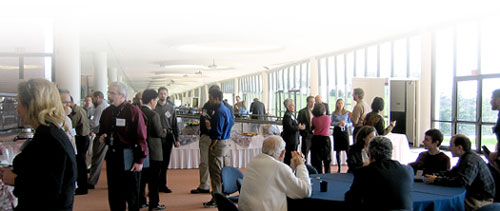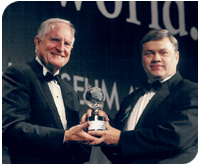 |
| volume 1, number 4 : winter 2003-2004 |
[Download free Acrobat Reader] |
|||||||||||||
| Contents: Goddard's Tech Management Work toward Common Goals Spinhirne Selected as Tech Museum Laureate the tech transfer process: Step 3: Seeking a Partner/Licensee researcher profile: James C. Tilton events: National Association of Seed and Venture Funds Conference Goddard and Nanotechnology Events Take Your Innovations to Trade Shows for Partnership/Licensing NASA's Top Tech Priorities Tech Transfer Metrics - October 1 - December 31, 2003 Tech Briefs in 2003 Send Us Your Ideas Submit Your New Technologies |
Goddard’s Tech Management Work toward Common Goals
"There’s a new emphasis in tech transfer beyond the traditional spin-out of our technologies," explained Nona Cheeks, Chief of the Innovative Partnerships Program Office. "We’re seeking more opportunities for spin-in to ensure that the NASA Centers are getting what they need, either from within NASA or from outside labs and companies. This new emphasis fits perfectly with the Chief Technologist’s goals. So working closer just made sense." As Goddard’s Chief Technologist, Dr. Polidan develops the Center’s roadmap for technologies as applied to NASA missions, sponsoring early R&D activities as appropriate. In addition, he coordinates with the R&D chiefs from other NASA Centers and other government laboratories, looking for opportunities to partner and collaborate. Similarly, the Chief Technologist sponsors and helps set up the exchange fellowship program to benefit research and technology knowledge sharing within Goddard. "Information sharing is key to closing the gap between scientists and engineers," said Dr. Polidan. "Scientists make some of the most important technological advancements, and engineers find a way to put those advancements into practical application. By working together earlier, including joint proposal development, these communities can make dramatic progress." The Innovative Partnerships Program Office is working closely with the Chief Technologist Office in identifying and arranging partnerships. "Forming partnerships is a major part of what we do," said Ms. Cheeks. "I think that’s an area where the Innovative Partnerships Program Office can be particularly helpful." |
|||||||||||||
Spinhirne Selected as Tech Museum Laureate
"It was an honor," said Dr. Spinhirne. "To be selected as a finalist, particularly by such a learned panel of judges, is definitely a level of recognition beyond what I expected." |
||||||||||||||
|
|
||||||||||||||
If the assessment of your technology-see the Fall 2003 issue of Goddard Tech Transfer News for more about technology assessment-recommends patenting and pursuit of transfer, the Innovative Partnerships Program Office begins securing the intellectual property rights and finding a viable partner/licensee. |
 |
Note: This series is examining the steps associated with spin-out of a Goddard innovation to a non-NASA application. Future issues of Goddard Tech Transfer News will explore the technology spin-in process.
What is the difference between a partnership and a license?
A partnership involves ongoing collaboration between Goddard and the partner. For example, the partner might use Goddard facilities, personnel, and/or equipment to further develop the technology for the commercial or non-NASA application. Depending on the arrangement, Goddard is reimbursed financially, or the partner contributes its own resources to further a NASA mission. A license agreement grants the licensee the rights (either fully or partially exclusive or nonexclusive) to manufacture or use the technology. The specific arrangement depends on the technology and its readiness to be transferred to the new application as well as what the partner/licensee can offer NASA.
How does the Innovative Partnerships Program Office find partners/licensees for my technology?
Because the assessment includes interviews with potential users and licensees, identifying most of the appropriate contacts has been done. Some additional research might be conducted to find others. Once the list of contacts is finalized, the Office explains the partnership/licensing opportunity, encouraging them to apply for use or license of the technology.
How does the Office communicate with these potential partners/licensees?
We use a variety of communication tools, according to what is most effective for the situation. The most common are the following:
- Technology Opportunity Sheets-One-page announcements succinctly presenting the technology and its potential applications and benefits
- Web sites-Some technologies can only be fully understood with many details, which are best presented online
- Industry briefings-Meetings hosted by NASA to explain the technology and the partnership/licensing opportunity.
- Trade show exhibits-Displays and/or presentations that introduce technologies available for partnership/licensing. (Upcoming trade shows)
What happens when one of the contacts expresses interest in becoming a partner/licensee?
The specifics vary from case to case, but in general the Innovative Partnerships Program Office requests a project or transfer plan that provides details about the organization, how it plans to use the technology, its financial stability, and the proposed terms for the agreement. Once the plan and other application forms have been received, negotiations begin.
Next issue - Step 4: Partnership/License Agreement

researcher profile:
James C. Tilton
 |
Code 935 Education:
Born: Burlington, Wisconsin |
What inventions are you currently working to transfer?
I am currently working to transfer my hierarchical segmentation software (HSEG) and related software. HSEG provides a new approach to image analysis, focusing on image regions-and how they change from a coarse-to-fine perspective-rather than just pixels.
What has the Innovative Partnerships Program Office done to introduce your invention to new users?
The Office has set up a Web page featuring HSEG, which lets prospective users acquire a demonstration version, and set up/facilitated several interviews. They also helped with two patent applications and created a poster for a trade show.
What do you see as the future for your technology?
The software already has been licensed to Bartron Medical Imaging. Eventually I would like to see it applied to a wide range of Earth remote sensing image analysis problems, knowledge discovery and data mining in imagery data archives, and medical image analysis.
Any advice for your colleagues? File those disclosure forms! Once you do, there will be many opportunities to publicize your development through the Innovative Partnerships Program Office.

Events
National Association of Seed and Venture Funds (NASVF) Conference
|
|
Goddard played an active role in this event, presenting the Hilbert-Huang Transformation (HHT) Method. Developed by Goddard’s Norden Huang (Code 971), HHT is a technology innovation that has significant potential for commercial and government program success. HHT was presented, and then tech-savvy investors evaluated the opportunity. Several suggestions were made on positioning the technology in a start-up environment, and potential interested companies were identified. These leads are being pursued.
Goddard and Nanotechnology Events
IPP and Dan Powell also participated at the Greater Washington Nanotechnology Alliance’s first special topics symposium. Held on November 25th in Laurel, Maryland, this day-long event was filled with presentations on topics ranging from public interest issues to technical practices, research, and potential/developing applications.
The event-as well as the Alliance itself-is mainly a knowledge-sharing and networking opportunity. "By knowing who the key players are, what they’re looking at, and where things can be combined, you can direct your efforts where they bring the most value," said Mr. Powell, who helped found the Alliance. "There’s not enough money for all of us to be working alone, so we’d better work together."

Take Your Innovations to Trade Shows for Partnership/Licensing
As discussed in step three of the tech transfer process, trade shows are a key way for the Innovative Partnerships Program Office to promote the spin-out opportunities at Goddard. Below is a list of upcoming trade shows. If you think your technology would be of interest to the attendees at one or more of these shows, please contact the Office by the indicated deadline.|
Event
|
Where, When
|
Deadline for Contacting Innovative Partnerships Program Office
|
| Society for the Advancement of Material and Process Engineering (SAMPE) |
Long Beach, CA;
May 16-20 |
March 19
|
| Sensors Expo & Conference |
Detroit, MI;
June 7-10 |
April 9
|
| NASA/TEDCO Technology Showcase |
Greenbelt, MD;
July 7 |
May 7
|
|

Tech Transfer Metrics
October 1 to December 31, 2003
New technologies reported: 23
New technologies were reported by the following civil servants, contractors, and universities:
Civil Servants
|
Universities:Indiana University |
Contractors:Constellation Software Engineering, Corp. |
|
Licenses/Partnerships: 2
|
|
Issued Patents: 3Innovators receive a $500 to $1,000 award for an issued patent
|
|
|
Patent Applications Filed: 3
|
|
|
Provisional Patents Filed: 5
|
|

Tech Briefs in 2003
Innovators receive a $350 award for a published Tech Brief
Code 500
Julie Crooke
Gary Davis
Carlos Hernandez
Maurice Lewis
Code 600
Donald Jennings
George McCabe
Dennis Reuter
Code 900
Norden Huang
Contractor
Richard Rallison - Ralcon, Inc.

Send Us Your Ideas
We want to do all we can to make it easy and rewarding for you to participate in the Technology Transfer Program. But we need your help. Send us your ideas for program improvements or News articles via email.
![]()

Submit Your New Technologies
You can report new project technologies by submitting the online form on eNTRe.

A publication of
Technology Transfer Program
Mailstop 504
Building 22, Room 290
(301) 286-5810
techtransfer@tco.gsfc.nasa.gov


